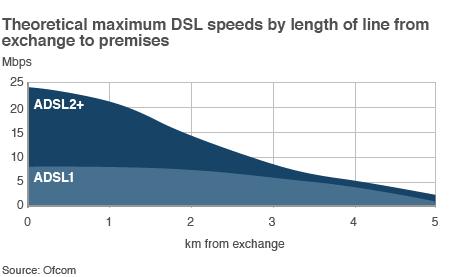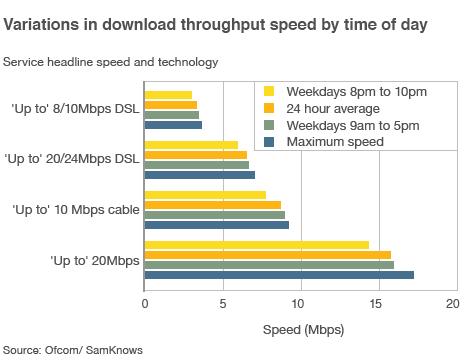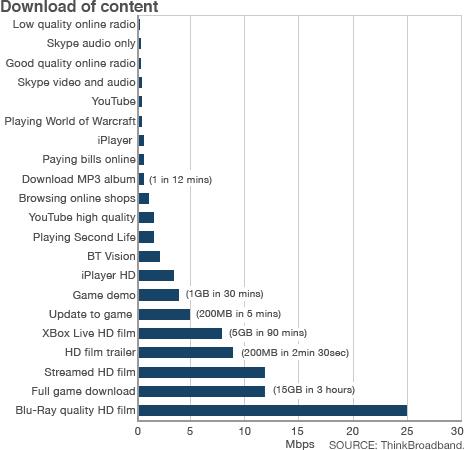Why does broadband speed vary so much?
- Published

The actual speeds of UK broadband services are still falling short of those advertised Ofcom has found
If you are a night owl who enjoys surfing between the hours of 4am and 6am and are fortunate enough to live on top of a telephone exchange then you are probably very happy with your broadband speeds.
But the majority of people in the UK are not getting the broadband services they signed up for, according to a comprehensive speedreport by regulator Ofcom.
The survey found that for DSL services advertised as being "up to" 20Mbps, only 2% of customers got speeds in the range of 14-20Mbps. Of the others, 32% were getting a 8-14Mbps service and 65%, 8Mbps or less.
So what are the factors that determine how slow your fast service will actually be?
Line length
With DSL services which run on the old copper wire telephone network (basically any service other than Virgin Media) the signal strength of a line is determined ultimately by physics.
"If you stand and shout at someone from 50 metres you will be heard better than from 100 metres," said Sebastien Lahtinen, co-founder of broadband news site ThinkBroadband.
It means that one of the biggest factors for those signed up to DSL packages is how far they live from a telephone exchange.

Ofcom estimates that the average "as-the-crow-flies" distance between user and the telephone exchange in their survey was 2.4km (1.49 miles) but anyone getting out their measuring sticks be warned: the physical distance you live from the exchange does not necessarily equate to the length of your telephone line.
"Telephone wires don't necessarily follow the obvious path and line distance may be significantly longer," said Mr Lahtinen.
So for instance in the Isle of Dogs, where a straight line from homes to exchange is 3km (1.8 miles), the line distance is actually 7km (4.3 miles).
Rush-hour
Another factor determining how fast your broadband speed will be is the time of day you surf. At peak times of the day there will be more people using the service which will make it slower for everyone.

For customers of Virgin Media's cable service, this rush-hour network congestion is the biggest factor.
"Differences between actual and advertised speeds on cable is almost entirely due to congestion because the cable that goes down the street is shared by everyone on it," said Ian Fogg, a senior analyst with research firm Forrester.
According to Ofcom, actual speeds at peak times for those using Virgin's 20Mbps service tended to be closer to 15.7Mbps.
At peak time someone using its 50Mbps service may see speeds fall to around 35Mbps. By contrast those able to stay awake until 4am will enjoy speeds close to the maximum - at 45Mbps.
New cabinets
For DSL providers, congestion is also an issue with some providers performing better than others.
While O2 does relatively well at peak times, others such as Orange and PlusNet are below average, according to Ofcom's figures.
"It's down to the nuts and blots of how a provider runs it network. Put in layman's terms it is about how big the pipes are between the ISP's network and other points on the net," said Mr Fogg.
Next-generation services, in the form of Fibre-to-the-Cabinet, which BT is rolling out to around two-thirds of homes in the UK could improve things.
Fibre-to-the-cabinet (FTTC), externalreplaces copper wiring between the telephone exchange and the green cabinets that house the wires at street level with faster fibre optic cables. The rest of the connection, between the green cabinet and the home would be provided by the latest generation of broadband telephone line (DSL), known as VDSL2.
"FTTC will dramatically improve the line length issue and a key factor in this will be the number of new street cabinets they build. This will depend on the level of investment they put in it," said Mr Fogg.
As speeds get higher, the distance between advertised and actual speeds will become less of an issue, thinks Mr Lahtinen.
"If you are on 100Mbps it doesn't really matter if you only get 50Mbps because that is still going to be enough for what you need," he said. Congestion on the network and the internet will still be an issue but other factors will become more important.

As more and more people use so-called cloud computing to store their data in the network, upload speeds will become increasingly crucial.
"Upload speeds haven't been the focus of Ofcom's research but they go up to around 2.5Mbps which could be a problem if you have a lot of photos to upload," said Mr Lahtinen.
As speeds increase, more focus will be put on the quality of a connection as people demand the best performance from voice and video services, he said.
Some factors determining the speed of your connection are closer to home, such as the wiring in a customer's house and the speed of their computer.
BT offers some practical help when it comes to wiring problems, with a device known as a broadband accelerator available free to BT Retail customers.
Formerly known as the iPlate, the broadband accelerator is a device which can be fitted into a main telephone socket to filter out interference. To date BT has sent over 140,000 accelerators to customers.
It shows there are things that individuals can do to improve their speeds but the bigger picture is that broadband speeds in the UK remain in the slow lane.
"Speeds have changed very little and for the UK to enjoy dramatic improvements there needs to be investment in fibre," said Mr Fogg.
As that investment gets under way, people lucky enough to be near a spanking new green box may have cause for celebration but broadband in the short-term remains something of a postcode lottery.
- Published27 July 2010
- Published15 July 2010